Ever tried to bond painted wood with glue and wondered why it’s not sticking as expected? Let’s see the science of effectively using wood glue on painted surfaces. Curious? Read on!
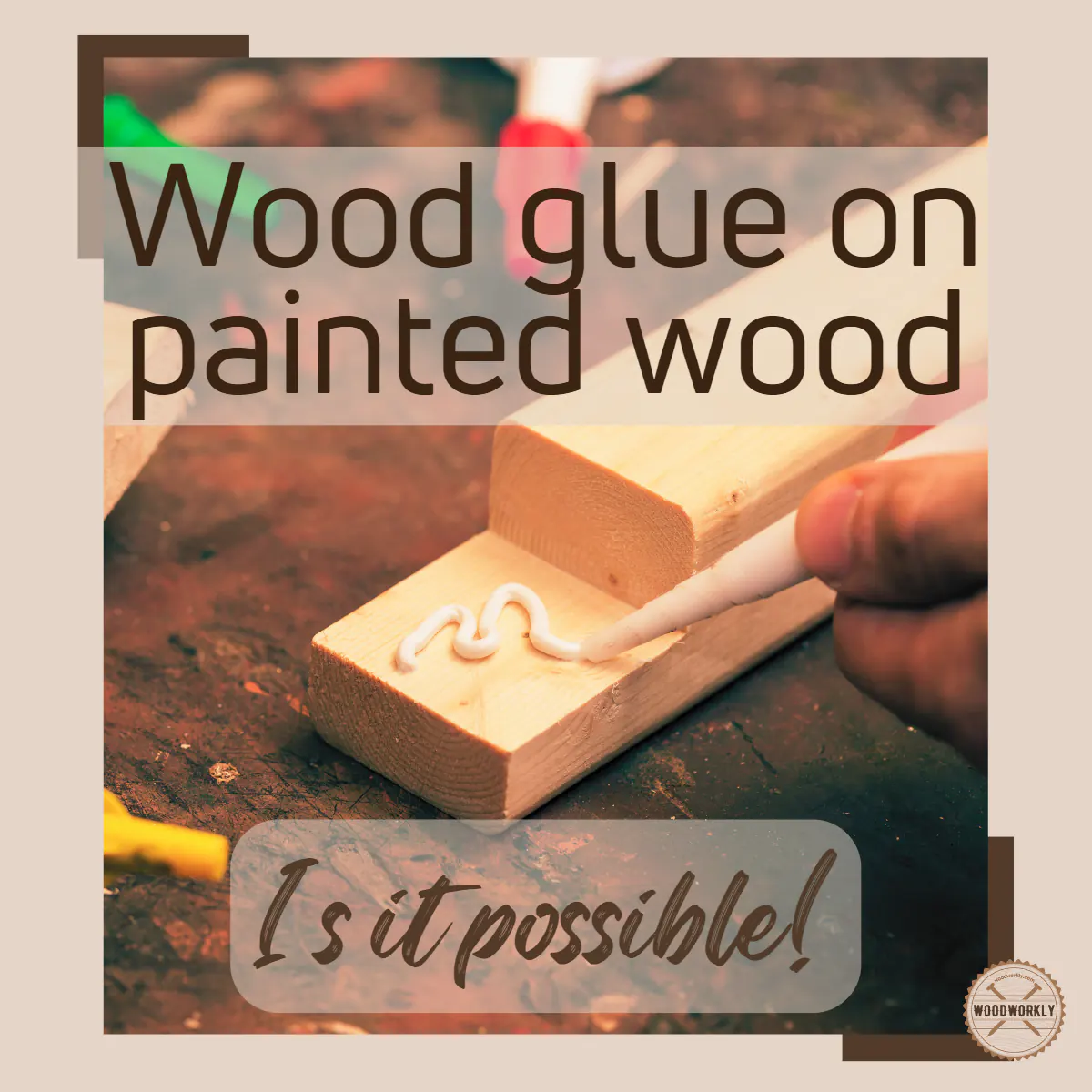
Wood glue is a strong adhesive that every woodworker uses to hold pieces of wood together.
When I was a beginner undertaking various woodworking projects, I was always afraid of gluing patined wood since I didn’t know how wood glue behaves with the painted wood.
So, I did deep research about this with experiments by taking different types of painted wood and was able to find a solution for gluing the painted wood.
Now, after years of woodworking and countless projects, here’s what I have learned: Does wood glue work on painted wood?
Yes, wood glue work on painted wood. But applying glue on top of the painted surface probably doesn’t give the strong joint you want. To achieve a strong joint between surfaces, glue needs to be penetrated the wood fibers, which doesn’t happen gluing painted wood.
But that’s just a quick snapshot of the question. Wood gluing is a wide field that develops continuously.

There are certain occasions we look for methods to bond fully cured painted surfaces with generic wood glue. The most raised question is will glue adhere well to the primer/paint?
So, in this article, I’ll explore a little deeper and make sure we answer all the questions regarding How does wood glue works on painted wood? What glue works on painted wood, Does wood glue stick to primer, and many more.
Let’s get going!

This post contains affiliate links. As an Amazon Associate, I earn from qualifying purchases. I endorse only products I truly recommend. If you make a purchase using one of these links, I may receive compensation at no extra cost to you. For more information, see my disclosure policies.
Can You Wood Glue Over Paint?
Yes, you can wood glue over paint, but it won’t give the best results from wood glue since wood glue makes a stronger and more stable bond with bare wood.
Most of the wood glues are designed to bond bear woods. If your wooden pieces are painted with oil-based paint, you need something different.
For oil-painted wooden surfaces, wood glue does not penetrate through wooden fibers to make a strong joint between them.
The paint layer blocks the pores of the wooden surface. This is why wood glue cannot penetrate the wood.
According to my experience, it is good to sand, scape, and cut off the paint before gluing the painted surface for a strong joint.
If you wish to apply wood glue to the painted surface, sorry to say the joint will not be as strong as the paint. Also note that the paint-to-glue adhere is so much weaker than the wood-to-wood glue joint.
If you want to attach two painted wooden surfaces without sanding, I highly recommend using Two-part epoxy or Polyurethane glue which will stick well with the painted surface and build up a stronger joint than in wood glue.
If you use epoxy, the paint tends to fall with time and the wood pieces will come apart with it.
If the surface is painted with oil-based paint, the only permanent solution is to strip the paint by sanding and join them with wood glue. Otherwise screws also an easier solution.
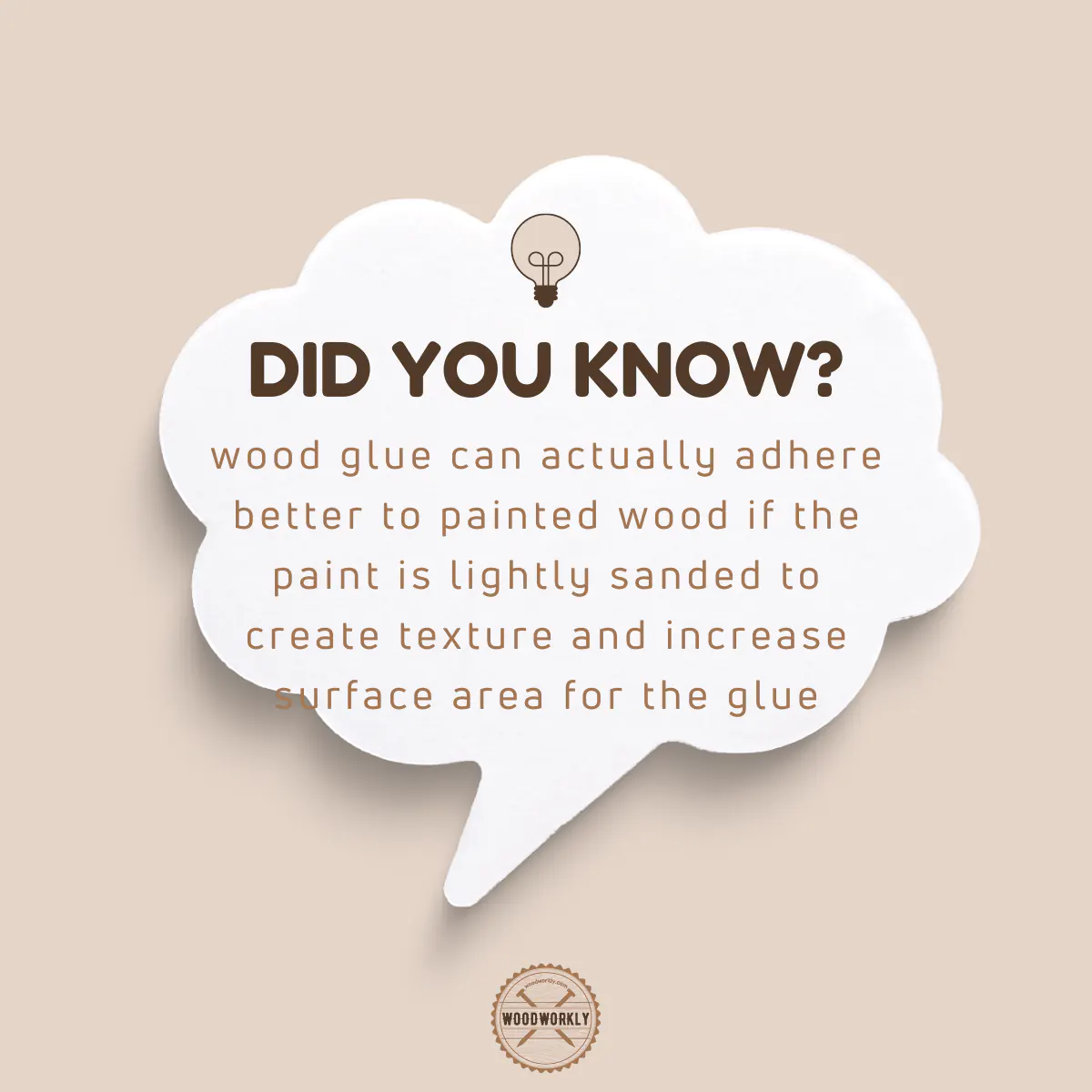
Wood Glue Over Water Based Paint
Water-based painted surfaces glue well well with some types of wood glue.
Acrylic paint and latex paint are water-based paints that can be glued together and provide good adhesion.
Water-based wood glue PVA (polyvinyl acetate) glues (“Yellow”) well over water-based paint like Acrylic paint or over latex paint.
The bonding agent of acrylic paint and latex paint is almost the same as the bonding agent of wood glue.
This is why PVA could make a good joint with the painted surface. But it can use for drywall as well.
PVA is a wood glue that works on painted walls. The adhesive properties of PVA glue are high and they have water resistance.
But I have to say that nothing builds the perfect joint as bare wood with wood glue.
Always use water-based wood glue to jin water-based painted surfaces.
Water-based paint glue is better than oil-based paint since the bonding agents of acrylic paint and latex paint are more compatible with oil-based paint.
On the downside, water-based paints can sometimes be more sensitive to moisture and temperature changes.
Therefore, you’ll want to consider the environment where your painted wood project will live and the type of stresses it might endure before choosing your glue.
Wood Glue Over Oil Based Paint
When we talk about oil-based paint, we’re referring to a category of paints that have pigments suspended in an oil or alkyd base.
Oil-based paints are highly regarded for their resilience and the smooth, attractive finish they offer.
They have excellent adhesion properties, making them a go-to choice for high-traffic or high-impact areas.
However, due to the oil content, these paints tend to dry slower than their water-based paints.
They also create a denser, non-porous layer once dried, which can present some challenges when it comes to applying wood glue.
Wood Glue and Oil-Based Paint: The Interaction
In contrast to water-based paints, the non-porous nature of oil-based paint creates a surface to which wood glue may struggle to adhere.
The dense layer prevents the glue from penetrating into the wood fibers, which is typically how wood glue forms a strong bond.
Despite these potential challenges, it’s certainly not impossible to get wood glue to adhere to an oil-based painted surface.
The key lies in choosing the right type of glue and appropriately preparing the surface.
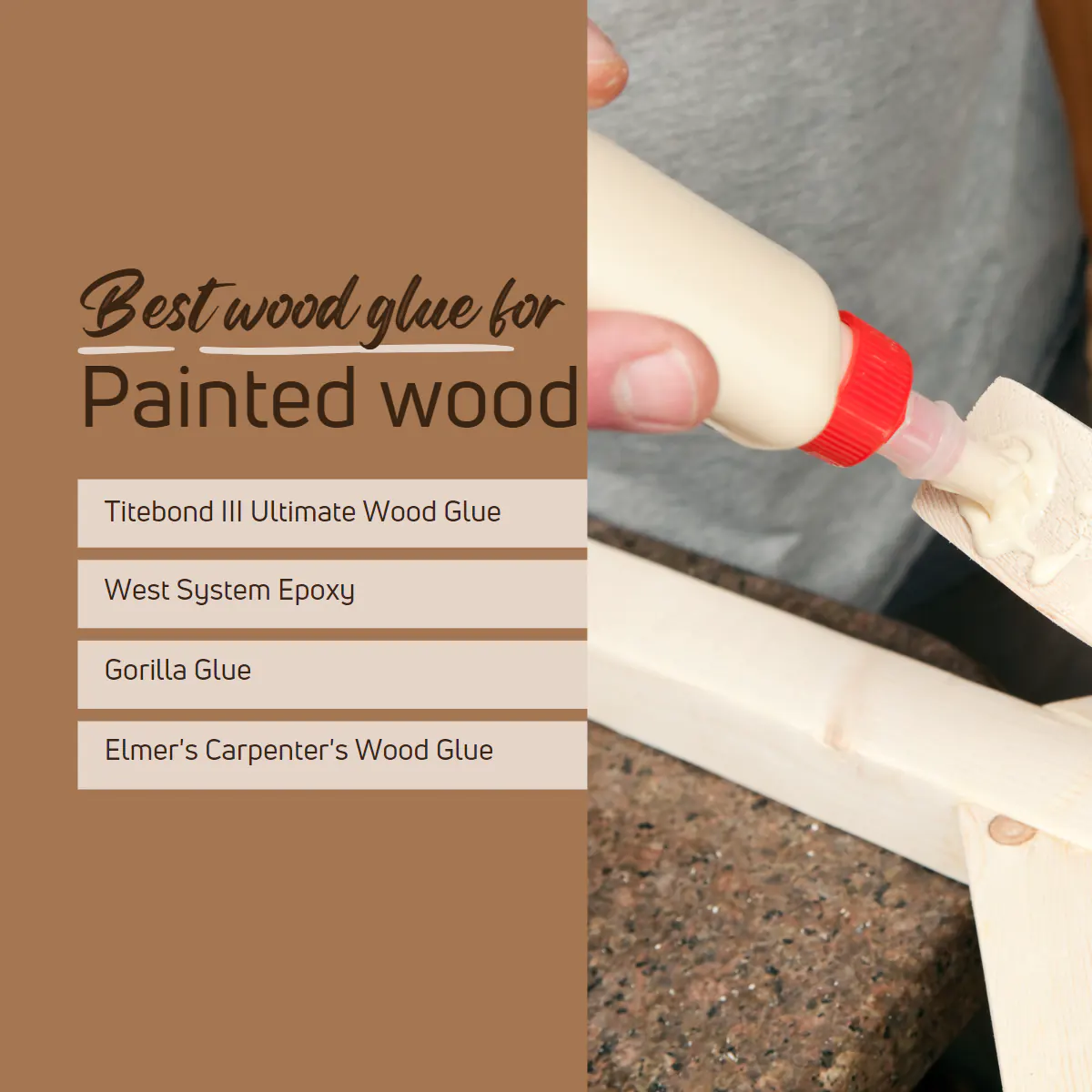
Best Glue For Painted Wood
I did some research to find out the different wood glues with their application on painted wooden surfaces.
| Types of Wood Glue | Use on Painted Wood |
| PVA glue (Polyvinyl Acetate glue) | Work better on Water-based painted wood |
| Epoxy glue | Work better on Oil-based painted wood |
| Polyurethane glue (PU glue) | Work better on Oil-based painted wood |
| Hide glue | Work better on Water-based painted wood (like PVA) |
| Hot glue | Work better on Water-based painted wood |
| Cyanoacrylate glue (CA glue) | Work better on Oil-based painted wood |
| Aliphatic Resin glue | Work better on Water-based painted wood |
So, let’s have a look at each of the above glue types and how they work on painted wood.
PVA Glue (Polyvinyl Acetate Glue) On Painted Wood
PVA glue is a classic white adhesive that’s a staple in every woodworker’s toolkit.
PVA (polyvinyl acetate) glue is a water-based adhesive that’s versatile and easy to use, making it a favorite choice for many crafters and DIY enthusiasts.
But when it comes to applying it on painted wood, there are a few things worth knowing. Let’s delve in!
Characteristics of PVA Glue
Before we talk about PVA glue’s compatibility with painted wood, let’s first understand what makes PVA glue special.
PVA glue is known for being easy to work with, non-toxic, and dries clear, making it a great option for a variety of projects.
In addition, PVA glue is generally water-resistant once dry, although it’s not typically classified as being fully waterproof.
PVA Glue and Painted Surfaces: A Perfect Match?
So, how does PVA glue interact with painted surfaces? Well, the good news is that PVA glue can indeed bond painted surfaces, as it has excellent adhesion properties.
But as always, the devil is in the details.
The quality of the bond will largely depend on the type of paint and the condition of the painted surface.
If the painted surface is clean, smooth, and not peeling or chipping, PVA glue should be able to form a strong bond.
Examples of PVA glues that are known to work well with painted surfaces include Titebond III Ultimate Wood Glue.
It dries clear and offers a robust bond, making it an excellent choice for bonding painted wood.
Considerations for Different Types of Paint
However, bear in mind that not all paints are the same.
Water-based paints are porous, which allows the glue to bond more effectively.
On the other hand, oil-based paints are denser and non-porous, which can make it trickier for the glue to adhere.
Therefore, PVA glue bond better with water-based paint than oil-based paint.
As you can see, PVA glue can indeed be used on painted wood, but the effectiveness of the bond will depend on various factors, including the type of paint and the condition of the surface.
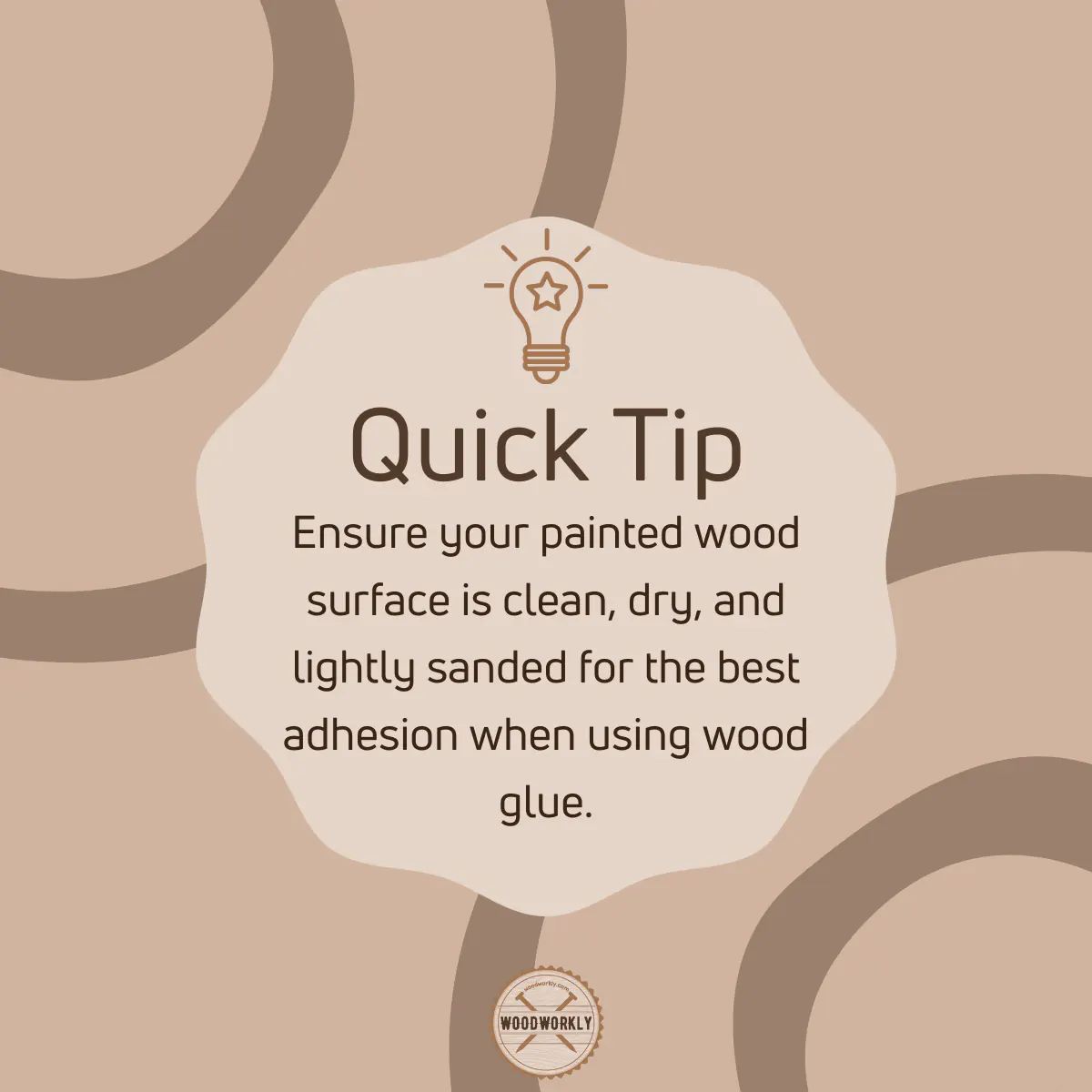
Epoxy Glue On Painted Wood
Epoxy glue, a high-performance adhesive, is actually a two-part system – a resin and a hardener – that when mixed together, create a chemical reaction resulting in a strong and durable bond.
It’s this incredible strength that makes epoxy glue popular for heavy-duty applications and environments that expose the bond to high stress or moisture.
Epoxy Glue and Painted Wood: A Powerful Duo?
You’ll be pleased to hear that epoxy glue can indeed bond painted wood surfaces effectively.
Thanks to its potent bonding capabilities, it can adhere to a variety of surfaces, including those covered in paint.
One example of a popular epoxy glue compatible with painted wood is the West System Epoxy, noted for its versatile bonding capabilities.
Its compatibility with painted surfaces, coupled with its strong, durable bond, makes it an ideal choice for more demanding projects.
Considerations When Using Epoxy Glue on Painted Wood
While epoxy glue generally works well on painted surfaces, the strength of the bond will depend on a few factors.
Epoxy glue tends to adhere better to surfaces painted with porous paints, such as water-based paints, due to its ability to allow the glue to seep into the pores and form a stronger bond.
In contrast, oil-based paints can be more challenging for epoxy glue to bond with due to their non-porous nature.
Additionally, the painted surface must be in good condition – free of peeling, flaking, or chipping paint – for the epoxy glue to adhere properly.
Epoxy glue can be a powerful ally when bonding painted wood surfaces, thanks to its superior strength and durability.
However, the success of your project will depend on various factors, including the type and condition of the paint and the environmental conditions.
Polyurethane Glue On Painted Wood
Polyurethane glue is a versatile, waterproof adhesive known for its ability to bond a wide array of materials, from wood to ceramics and even metal.
It’s a favorite choice for both indoor and outdoor projects, thanks to its robust and resistant properties.
One of the biggest advantages of polyurethane glue is its compatibility with painted wood. It’s no secret that paint can sometimes pose a challenge to adhesives, but polyurethane glue is up for the task.
When applied to a properly prepared painted wood surface, this adhesive can create a secure and durable bond.
For instance, Gorilla Glue, a well-known brand of polyurethane adhesive, is often hailed for its strong bonds and suitability for a range of applications, including on painted wood surfaces.
Factors to Consider
While polyurethane glue is generally an excellent choice for painted wood, it’s still crucial to consider a few key factors:
The State of the Paint: Polyurethane glue can bond to painted surfaces, but it’s crucial to ensure that the paint is in good condition. If the paint is peeling, flaking, or chipping, it can compromise the bond.
Type of Paint: The type of paint can also influence the bond. Polyurethane glue might not adhere as effectively to some types of paints, particularly those that are oil-based, as they create a smoother and less porous surface.
Testing the Bond: It’s always a good idea to test the bond on a small, inconspicuous area of your project before you go all in. This will help you identify any potential issues and adjust your approach if necessary.
Hide Glue On Painted Wood
Hide glue is an adhesive made from animal collagen, typically derived from the hides and bones of cattle. It’s a beloved classic in woodworking, famed for its reversibility, long open time, and unique properties that enhance wood finishes. Despite modern alternatives, many artisans still swear by this traditional adhesive for specific projects.
Hide Glue and Painted Wood: A Complex Relationship
Hide glue, with its natural origins and unique properties, has a rather complex relationship with painted wood surfaces.
Here are some important considerations:
Traditional Context: In a traditional woodworking context, hide glue is often applied directly to the wood. The adhesive is known to penetrate the wood fibers, creating a strong bond. When it comes to painted surfaces, the paint can act as a barrier, preventing this deep penetration and potentially reducing the effectiveness of the bond.
Compatibility: While hide glue might not form the strongest bond with painted surfaces, it’s not to say it can’t be used. You could potentially use hide glue on painted wood in decorative or non-structural applications, where the strength of the bond is less crucial.
Reversibility: One of the unique properties of hide glue is its reversibility. This means you can heat the glue joint to disassemble it, making it a great choice for restorations or projects where you may need to undo the bond in the future. This feature might not be as effective on painted wood, but it’s a good point to keep in mind.
Choosing the Right Glue for Painted Wood
While hide glue has many advantages, for projects involving painted wood, other glues might be more suitable.
Polyvinyl acetate (PVA) glues, epoxy resins, and polyurethane-based adhesives, for instance, are all excellent choices that provide a stronger bond with painted surfaces.
To sum up, hide glue on painted wood is not an outright no-no, but it might not always be the best choice depending on your project’s needs.
If you’re working on a non-structural project or a restoration, hide glue could be a viable option.
Hot Glue On Painted Wood
Yes, hot glue work on painted wood.
The hot melted liquid-like gel will penetrate through painted wood and stick to the wood pieces.
Hot glue is made of thermoplastic polymers combined with wax.
I recommend you use Surebonder #810R low melt high-performance hot glue type to use for painted wood.
Hot glue, often known as hot melt adhesive, is a thermoplastic adhesive that is heated in a glue gun before application.
Its charm lies in its quick setting time, versatility, and ability to bond a wide range of materials.
So, let’s see where painted wood fits in this picture.
Hot Glue and Painted Wood: The Good and The Bad
The interaction between hot glue and painted wood is indeed an interesting one.
Here are some key points to note:
Bonding Capabilities: Hot glue is often lauded for its ability to bond different materials effectively, and painted wood is no exception. It can create a relatively strong bond with painted surfaces, making it a useful adhesive for quick fixes and lightweight crafting projects.
Non-Damaging: Unlike some other adhesives, hot glue does not usually damage painted surfaces. It cools and solidifies upon contact, minimizing the risk of damaging the paint. Plus, if you make a mistake, you can often peel it off without leaving much of a mark!
Limitations: But hot glue is not perfect. It’s not the most robust adhesive out there. For projects that require a strong, long-lasting bond or will be exposed to high stress, heat, or moisture, hot glue may not be the ideal choice. Additionally, the bond strength can be reduced if the paint layer is thick or flaky, or the paint isn’t well-adhered to the wood.
Consider Your Project Needs
Like every adhesive, hot glue has its time and place.
For small craft projects, temporary fixes, or decorative applications, hot glue on painted wood can be quite effective.
However, for heavy-duty or outdoor projects, you might want to consider stronger adhesives, such as epoxy resin or polyurethane-based glues, which offer greater durability and resistance to various environmental factors.
If you need to know more, read my latest guide about using hot glue on painted wood!
Cyanoacrylate Glue On Painted Wood
Cyanoacrylate glue, or “CA glue,” is well-known for its quick-drying properties and high strength.
This versatile adhesive is a handy tool for both minor household repairs and intricate craft projects.
But what happens when you apply it to a painted wood surface?
While the bonding process might not be as perfect as it is with raw wood, cyanoacrylate glue can still work well with painted wood, depending on the circumstances.
Let’s break down what this looks like.
Bonding Power: Super glue is renowned for its strong bonding ability, and this holds when you’re working with painted wood as well. It adheres quickly and creates a solid bond, particularly for small fixes or craft projects.
Versatility: Cyanoacrylate glue works with a wide array of materials, and painted surfaces are no exception. This versatility makes it a valuable adhesive to have in your DIY toolkit.
Surface Challenges: However, the success of using super glue on painted wood largely depends on the condition of the painted surface. If the paint is uneven, chipped, or flaking, it could affect the glue’s bonding strength. The adhesive might end up bonding to the paint, and if the paint isn’t well adhered to the wood, it could cause failures.
Best Practices
When using cyanoacrylate glue on painted wood, always ensure the paint is in good condition and properly adhered to the wood.
Smooth, well-adhered paint will give the glue a more secure surface to bond with, resulting in a stronger, more durable connection.
While cyanoacrylate glue can work on painted wood, the success of the bond is influenced by the paint’s condition.
It’s a powerful, versatile adhesive that, when used correctly, can yield excellent results.
Aliphatic Resin Glue On Painted Wood
Aliphatic resin glue, often referred to as “carpenter’s glue” or “yellow glue,” is a favorite among woodworking professionals and hobbyists alike.
Known for its quick drying time, excellent bonding strength, and ease of use, aliphatic resin glue is often a go-to for many wood projects.
In general, aliphatic resin glue is designed to bond with the fibers of raw wood to form a strong joint.
But what about painted wood surfaces? Here’s what you need to know.
Bonding Challenges: The primary challenge of using aliphatic resin glue on painted wood is that the glue is designed to penetrate wood fibers, and paint can prevent this from happening. This means the glue may end up sticking to the paint rather than the wood, and if the paint peels or chips, it might compromise the bond.
However, It’s Not Impossible: Despite these challenges, aliphatic resin glue can still be used on painted wood under certain conditions. The key is to ensure that the paint is firmly adhered to the wood and is not peeling, chipping, or flaking.
Things to Keep in Mind
Before applying aliphatic resin glue to the painted wood, check the condition of the paint.
If the paint isn’t in good shape, the bond strength might be compromised.
Congrats folks! Now you know how different types of wood glue react with painted wood.
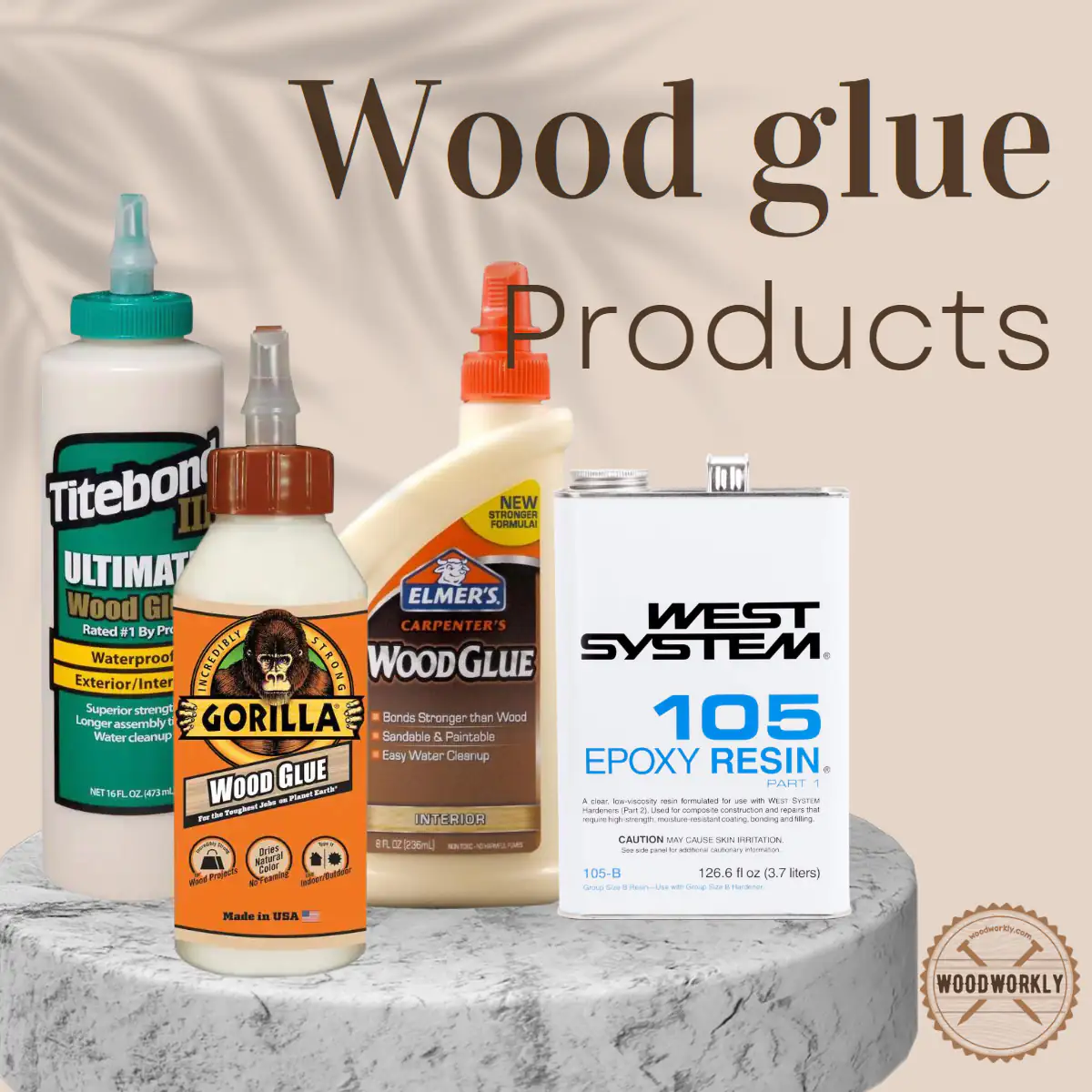
Let’s see the procedure of using wood glue on painted wood.
How to Glue Painted Wood?
Let’s dive into a step-by-step guide on how to glue any kind of wood with the wood glue you selected.
Here’s the procedure you need to follow when gluing painted wood,
- Check the paint condition
- Prepare the painted surface
- Select the right glue
- Apply wood glue
- Clamp the bond
- Let the glue cure
So, gather your tools, and let’s get started!
Step 1: Assess the Paint Condition
First and foremost, give your painted wood a good examination. Look for any signs of peeling, flaking, or chipping paint.
If the paint isn’t adhered well, your glue might not bond properly, causing problems down the line.
So, be sure to remove any unstable paint layers with a scraper or sandpaper.
Tip from the Bench: Don’t rush through this step, ensuring the paint is in good condition is critical for the success of your project.
Step 2: Prep the Painted Surface
Now that you’ve assessed the paint condition, it’s time to prep the surface.
- Clean the surface: Wipe down the painted wood with a damp cloth to remove any dirt, dust, or debris. You want to be sure that your glue is bonding to the paint, not any surface contaminants.
- Sand the Surface: Grab some medium-grit sandpaper (120-150 grit), and lightly sand the painted surface to create a rough texture. This will improve the adhesion of the glue. Be careful not to sand through the paint layer, as you don’t want to expose the bare wood.
- Wipe clean: Use a tack cloth or a damp cloth to remove any dust or debris from the surface after sanding. Make sure the surface is completely dry before moving on to the next step.
Step 3: Choose the Right Glue
Based on the paint and wood type, choose a suitable wood glue.
Some common options include PVA glues, epoxy resins, or polyurethane-based adhesives.
Make sure to consult the manufacturer’s instructions and recommendations to ensure compatibility with your project.
Step 4: Apply the Wood Glue
Ready to get your glue on? Follow these steps:
- Apply a thin and even layer of glue to the painted surface using a brush or a roller.
- Take care not to apply too much adhesive, as this can cause the bond to weaken and lead to squeeze-out or glue seepage.
- After applying the glue, align the painted wood pieces and gently press them together. Ensure that the entire glued surface makes contact for a secure bond.
Remember! Wood glue is not a ‘the more, the merrier’ situation. Applying a thinner layer usually leads to a stronger bond.
Step 5: Clamp It Up
Clamping is an essential step for any glued wood project.
Use clamps to secure the wood pieces in place while the glue dries.
This maintains consistent pressure and ensures a tight bond.
Just remember, don’t overtighten the clamps as it can cause squeeze-out and potentially damage the wood.
Step 6: Let the Glue Cure
Every type of wood glue has a different curing time.
Consult the manufacturer’s instructions for the recommended drying time.
Most wood glues will require at least 24 hours to cure fully, but some may need up to 72 hours for maximum strength.
Pro Tip: Don’t rush the curing process! It can be tempting to move on with your project, but the wait will ensure a secure bond.
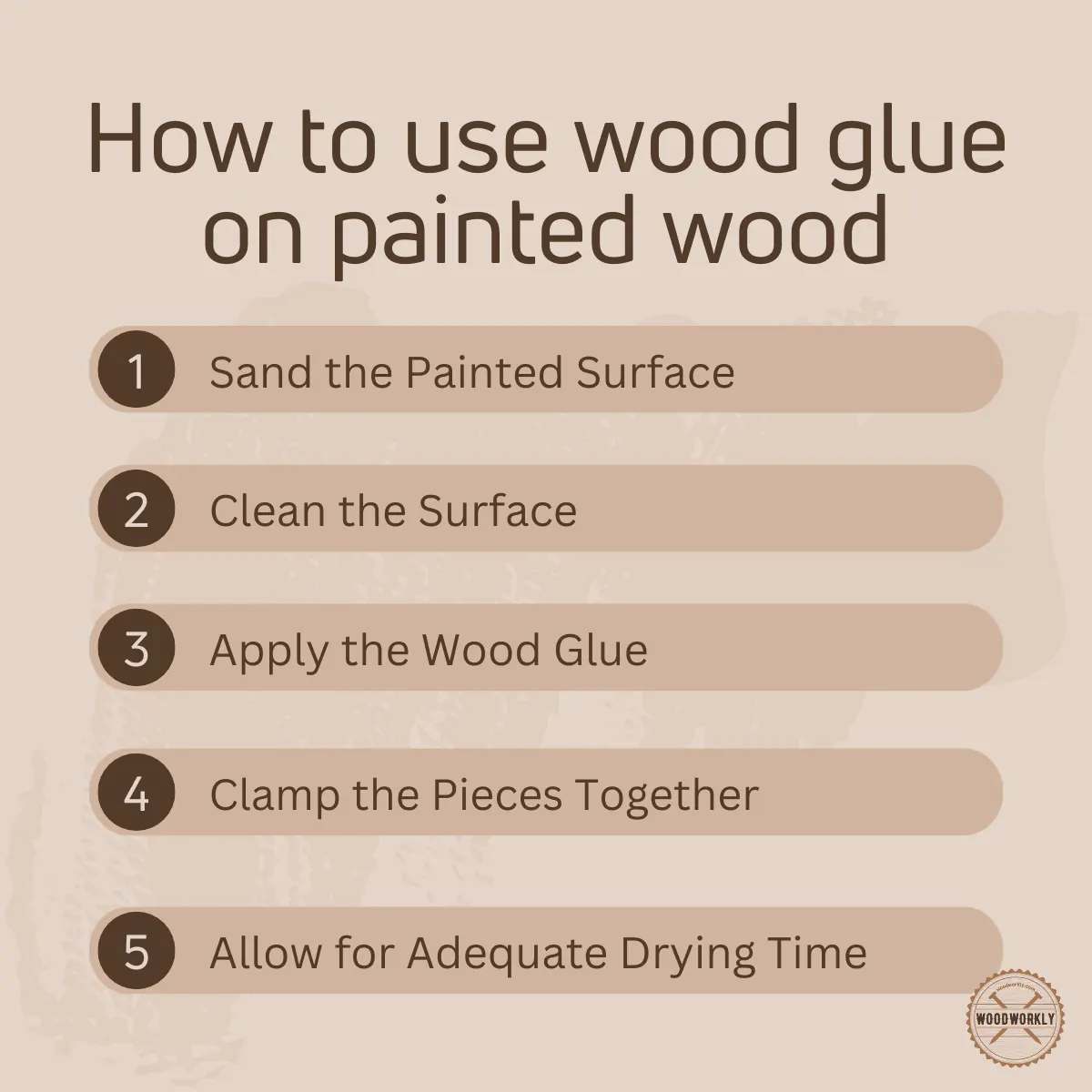
Does Wood Glue Stick to Primer?
No, wood glue does not stick to primer well as bare wood. Especially if the primer is oil-based, it won’t let wood glue penetrate the wood to make a strong joint.
If you wish to apply wood glue on top of the primer, my advice is to let the primer dry and scratch it carefully using fine sandpaper.
Because for a good glue bond, the primer needs to be taken off. Otherwise, the joint can be creep over time. Try to gain the rough surface.
Let it air dry for few minutes and apply the wood glue to it. Here we mostly use yellow glue (PVA glue) as wood glue.
If your primer is water-based, then you’re good to go with applying wood glue on top of the primer surface.
To tackle this question, let’s first understand what a primer does.
A primer is an undercoat that prepares the surface for the subsequent application of paint.
Its main functions are to provide adhesion for the paint, and in some cases, to seal the wood and prevent tannins from bleeding through the paint.
However, a primer is not specifically designed to provide adhesion for glue. That’s the job of the surface to which the glue is being applied.
So, while you can apply wood glue over a primed surface, your results might not be as strong or reliable as if you were gluing bare or sanded wood.
The Primer and Wood Glue Interaction
Here’s the deal: wood glue is designed to soak into the fibers of the wood, creating a strong bond that holds the pieces together.
When you apply wood glue to a primed surface, you are essentially sticking the glue to the primer, not the wood itself.
While primer does enhance adhesion, it doesn’t possess the same porous, absorbent properties as wood, which can affect the strength of the bond.
It’s not that the wood glue won’t stick, it’s that the bond might not be as strong or as durable as it would be if the glue were applied directly to the wood.
Exceptions and Best Practices
However, there are exceptions to the rule.
Some types of glue, such as epoxy or polyurethane, can create a strong bond even with a non-porous or sealed surface like a primed one.
These adhesives cure through a chemical reaction, allowing them to bond surfaces that other glues can’t.
In general, though, if you’re planning to glue pieces of wood together, it’s best to do so before priming and painting.
This will give you the strongest bond possible and prevent potential problems down the line.
Let’s take an example from my personal DIY journey. I was working on a project that involved gluing together some primed pieces of wood.
Not thinking much about it, I applied the wood glue over the primer. While the pieces did stick together initially, I noticed after some time that the bond wasn’t as strong as I had hoped.
When the project was subjected to a bit of stress, the glue joint began to fail.
This isn’t to say that you’ll never be able to get wood glue to stick to primer, but rather that it might not be the most reliable method.
As always, it’s important to consider the specifics of your project and the materials you’re working with.
Will Construction Adhesive Stick to Painted Wood?
Yes, construction adhesive sticks to painted wood better than wood glue.
You just have to apply construction adhesive on top of the painted surface and press down for about 30 seconds and disengage them.
This will stick perfectly. Because of the thickness of construction adhesives, they’re able to build thicker bead than wood glue does.
This will eventually develop solid strong contact between painted wood surfaces.
Construction adhesives are too thick, and they’ll never penetrate the wood like wood glue.
As an example, if you don’t have any clamp, nail, or screws to attach two painted wood pieces or the pieces are so small to use, construction adhesives can do the job.
They also work under moisture are present.
Ultimately, construction adhesives can work as an alternative option for occasions where we cannot use wood glues especially because of their water resistance.
Construction adhesive is a powerful adhesive designed for heavy-duty applications and materials.
It’s commonly used to bond different materials such as wood, concrete, stone, and more.
Unlike typical wood glue, it doesn’t rely on soaking into the material’s pores to form a bond.
Instead, it cures through the evaporation of water or solvents, or through a chemical reaction.
This means it can stick to a wide variety of surfaces, including painted wood.
Sticking to Painted Wood
While construction adhesive can indeed stick to painted wood, it’s important to remember that in this scenario, the adhesive is essentially sticking to the paint, not the wood itself.
This means that the bond’s strength will largely depend on the paint’s adhesion to the wood.
If the paint is peeling or poorly adhered, the bond between the adhesive and the painted wood may not be strong or reliable.
Prepping the Surface
In any case, preparing the surface appropriately can make a huge difference.
If the painted wood is smooth and glossy, you might want to consider lightly sanding the area where you plan to apply the adhesive.
This will help create a rougher surface for the adhesive to grab onto, resulting in a stronger bond.
Let me share a story from my own experience. I was working on a DIY project and needed to adhere a piece of metal to a painted wood surface.
I decided to use construction adhesive, considering its reputation for bonding different types of materials.
Despite the wood being painted, the adhesive worked like a charm! It formed a solid, secure bond that held up excellently.
However, I made sure to prepare the surface adequately by sanding the paint lightly to create a rough texture for better adhesion.
Choosing the Right Adhesive
Not all construction adhesives are created equal, though.
Be sure to choose an adhesive that is compatible with the materials you’re working with.
Some adhesives are formulated to work best with specific materials.
The product’s label should provide information about what materials it is suited for.
What Is the Strongest Wood Glue?
Polyvinyl Acetate glue (PVA glue) also known as “Yellow” is the strongest and most durable wood glue on the market.
If your painted wood, with water-based paint, I highly recommend you use PVA glue because it is better than all other glue types.
Polyvinyl Acetate glue (PVA glue) is the second-best option you can go to attach painted wood surfaces without a single piece of sanding.
It can use not only for wooden surfaces but also for metal, foam, ceramic, concrete, and glass as well.
Polyvinyl Acetate glue (PVA glue) has great water resistance, non-toxic strong adhesive, and is also great for all indoor and outdoor applications.
In my experience the best Polyvinyl Acetate glues available on the market are,
- Gorilla wood glue
- Titebond 2 wood glue
Both of them can do a great job and wood glue work on painted wood as well.
Does Gorilla Glue work on Painted Wood?
Yes, Gorilla glue works well on painted wood. It is PVA glue with great adhesion.
It is a water-based glue with water resistance. Most importantly it is transparent once it dries.
So, in my opinion, Gorilla Glue is a quality wood glue you can use for painted wood without any concern.
Check out, How to Remove Gorilla Glue from Wood? (EASY Guide!)
Does Titebond Work on Painted Wood?
Yes, Titebond works well on painted wood, but with some caveats.
The bond might not be as strong as it would be on bare wood, and the success can greatly depend on the quality of the paint job and the preparation of the surface.
Titebond is a PVA (polyvinyl acetate) wood glue, and its strength comes from penetrating the wood fibers and hardening.
When you’re working with painted wood, Titebond will be adhering to the paint layer, not the actual wood.
As such, its effectiveness will largely depend on the quality of the paint job.
If the paint is firmly adhered to the wood, then Titebond can form a bond with the paint. However, it might not be as strong as when it’s used directly on wood.
I once used Titebond to fix a broken painted wooden picture frame. The break was clean, but the wood was painted.
I sanded the paint a bit at the broken parts, applied Titebond, clamped it, and left it to dry.
To my delight, the frame held up just fine! The glue did its job, but I believe the sanding prep step made a significant difference.
Super Glue Over Painted Wood
Super glue can work on painted wood, but the strength of the bond can vary depending on the quality of the paint job and the surface preparation.
It can be handy for quick fixes, but for more durable or load-bearing projects, you might want to consider other types of adhesive, or stripping the paint and applying the glue directly to the wood.
Super glue is known for its fast setting and strong bonding characteristics.
It can bond a variety of surfaces – from plastic to metal, and yes, to wood as well.
When it comes to painted wood, the success of super glue largely depends on the state of the paint and the surface underneath it.
Super glue adheres best to rough surfaces, and since paint typically creates a smoother surface, the bond may not be as strong.
Additionally, the glue bonds to the paint, not directly to the wood.
If the paint isn’t properly adhered to the wood, it might peel off, taking the glued joint with it.
Personal experience with super glue on painted wood
I remember a time when I had to quickly fix a decorative, painted wooden item that had broken.
I didn’t have time for a full repair, so I grabbed my trusty super glue.
I roughened the painted surfaces a little, applied the glue, held the pieces together for a minute, and voila – the item was back in one piece.
It held up quite well for a temporary fix, though I wouldn’t expect it to withstand any heavy stress or load.
Can You Paint Over Wood Glue?
Yes, you can paint over wood glue. You can apply paint over wood glue without using any primer.
Let the wood glue dry for 24 hours before painting. Titebond 1, 2, and 3 can be painted over and they stick with paint so well.
First, try wood glue on scrap wood and paint to see the result before apply on the main project.
That’s it, folks! Hope you learned everything you wanted to know about, Does wood glue work on painted wood?
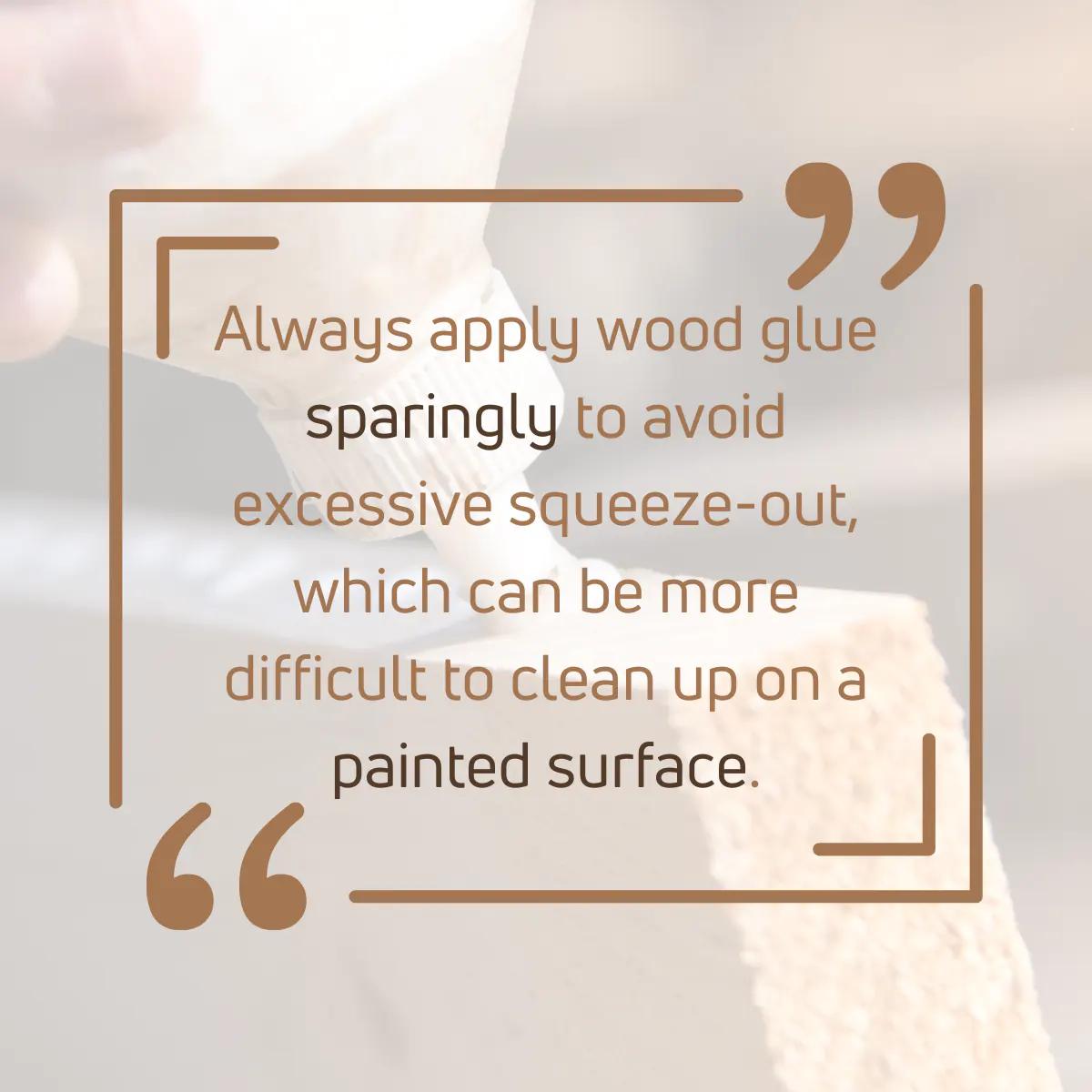
Let’s answer some frequently asked questions.
Can I use PVA glue on painted wood?
Yes, PVA glue can work on painted wood, but keep in mind it may adhere more to the paint layer than to the wood itself, possibly causing issues if the paint isn’t strongly bonded to the wood.
Is epoxy glue suitable for painted wood?
Yes, epoxy glue can be used on painted wood and often provides a strong bond, but its effectiveness may be affected by the quality of the painted surface.
Does hot glue stick to painted wood?
Hot glue can stick to painted wood, but it might not provide a very strong or durable bond, especially under stress or heat.
What are the steps to glue painted wood?
The key steps involve cleaning the surface, sanding if necessary, applying the chosen glue, clamping the pieces together, and allowing adequate drying time.
Does wood glue adhere to primer?
Wood glue can stick to primer, but it’s generally more effective on bare wood, as the primer can interfere with the glue’s ability to bond with the wood fibers.
Did I Cover all you wanted to know about: Does Wood Glue Work on Painted Wood?
In this article, I took a deep look at how does wood glue work on painted wood, what types of wood glue work perfectly over painted wood, what is the strongest wood glue and many more!
Wood glue can adhere to painted wood, but its effectiveness often depends on the paint’s quality and adhesion to the wood. For a stronger bond, it’s generally recommended to sand the painted surface lightly before applying the glue, allowing the adhesive to penetrate and bond directly with the wood fibers.
Apply wood glue when the paint is fully dried and cured. PVA glue, Epoxy, and Polyurethane are the best glues that work on painted wood.
At the end of the day, my advice as a long-time woodworker is, Whatever the wood you’re working on, always make sure to apply wood glue before the paint or primer.
Also, if you want to apply wood glue to painted wood, I highly suggest you do your best to take the paint away without just directly applying any type of wood glue.
Because nothing builds strong joints as bare wood-to-wood glue joints.
Hope this article will help you to face such circumstances without any issues with proper guidance.